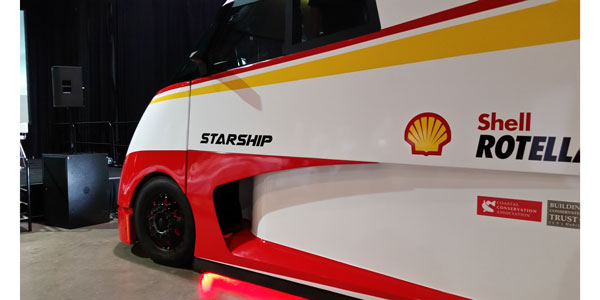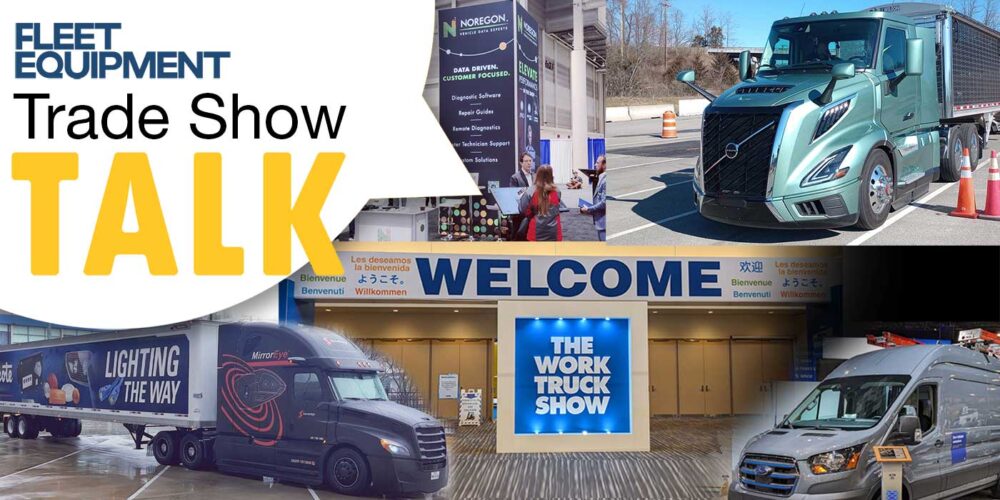The Starship truck from Shell, unveiled earlier this year, is intended as a conversation piece. When talking with Shell about why they built this futuristic vehicle, which is built to maximize freight ton efficiency using technologies that are available today, the term often thrown around is that the truck is a “thought leadership paper on wheels.” Shell says that they want to change the way people in the trucking industry think of fuel efficiency, aerodynamics, and what’s possible.
The thought leadership paper had its first exam last week, when it completed its cross-country run from San Diego, Calif. to Jacksonville, Fla. According to numbers from Shell that were independently verified by the North American Council for Freight Efficiency (NACFE), which followed the truck on its run, the truck achieved an average of 8.94 MPG (the national average for Class 8 trucks is 6.4) and a freight ton efficiency of 178, which is 248% better than the national average of 72.
While in Jacksonville to see the truck and hear the results, FE sat down with Chris Guerrero, global brand manager for heavy-duty engine oils with Shell, and Bob Mainwaring, Shell’s technology manager for innovation, to discuss the truck’s cross-country run and what’s next for the Starship.
On what they’ve taken away from the coast-to-coast run:
Bob Mainwaring: The way drivers behave or don’t behave is the major takeaway. When you think about driving style, and how important that is, it’s inevitable that when you accelerate away, you burn a lot of energy to get the vehicle up to speed. And you can’t avoid that, that has to happen. But what you can do once you’re at that point is be diligent and look ahead, and minimize the amount of braking you do—it’s the braking that makes you lose energy, so you want to avoid braking unless you have to. So if you can see traffic lights a mile away, and you can coast down to them, you’re not burning any fuel and still going a long way. That’s an efficient driving style, because you’re not converting braking energy into heat. Also, if you have a choice, avoid hills, drive on the flat. That driving component is a significant component in the total fuel economy. I don’t think the driving would offset all of the benefits of the Starship, if you drive like a disaster, but it would certainly deteriorate it quite significantly.
On whether those numbers could be improved on future runs:
Chris Guerrero: These things have been rolled out before. And they’ve been rolled out in controlled environments to get positive data. We said we wanted to do something different. If you want to start a good conversation, then you have to be willing to take a couple of risks, you have to be able to say that some things aren’t going to work, and that’s OK. This was not an optimized route—you could contend that this is the worst fuel performance you can see for this truck and it’s still considerably better than what we see on market. The whole point of it was: real load, real operating conditions, real truck stops.
On what’s next for the Starship:
CG: The first step is going to be looking through all of the data. There are things that we saw that we want to go back and explore. What I’d like to see is we get it in the shop, look at the data, come up with a list of four or five things that we want to tweak, and then run a different type of fuel trial and see what we get. Again, if the entire point is to drive the conversation, then let’s keep it going. Keep learning. We’ve already built the truck!
BM: There will come a point when we think we’ve gone far enough with it, but we think that point is a long way away. I think the improvement potential is significant still.
CG: The good thing about doing this kind of base-case run is that now we can do a different run with the Hyliion axle [which is not in the Starship truck as of now, but is scheduled to be in the near future], we can go back to our partner Hyliion and say ‘this is what we saw without the axel, this is what we saw with it.’ It’s mutually beneficial.
BM: I wonder if this might spark somebody else to do the same–we’ve got our freight ton efficiency number, can you do better? I’d love to see somebody try. I don’t feel precious about this being the winner all the time. And again, that moves the conversation on.
On whether there will be a Starship 2.0:
CG: Maybe more like a Starship 1.5. Taking what we have, and applying the knowledge, adding improvements, adding components and seeing the difference that that makes. And then we’ll see—maybe 2.0 later on.














